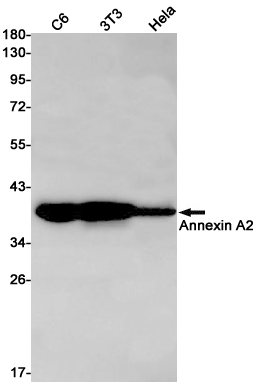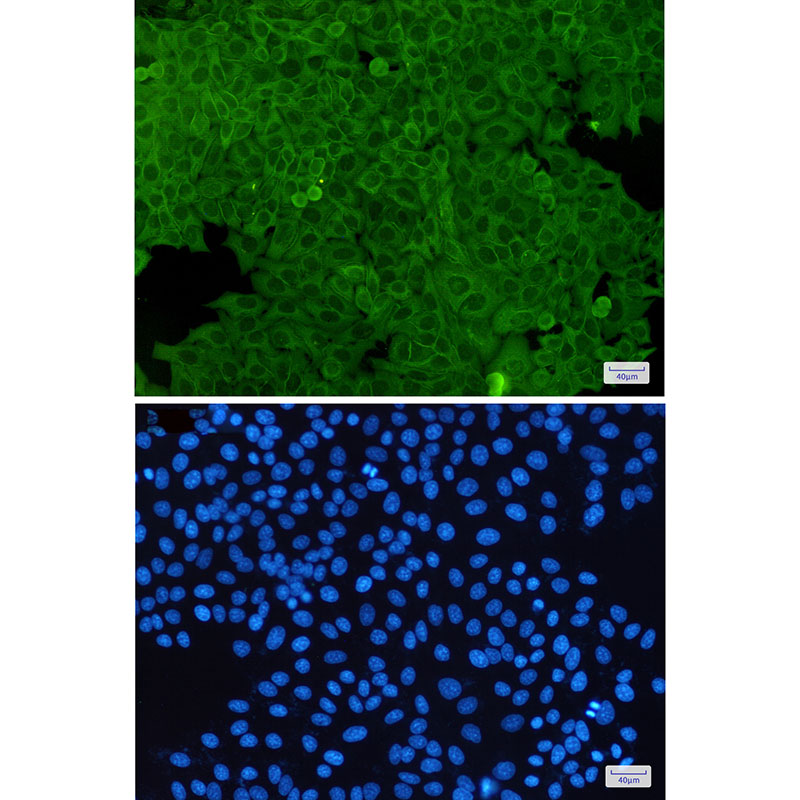

| WB | 咨询技术 | Human,Mouse,Rat |
| IF | 咨询技术 | Human,Mouse,Rat |
| IHC | 咨询技术 | Human,Mouse,Rat |
| ICC | 1/50-1/200 | Human,Mouse,Rat |
| FCM | 咨询技术 | Human,Mouse,Rat |
| Elisa | 咨询技术 | Human,Mouse,Rat |
| Aliases | ANXA2; ANX2; ANX2L4; CAL1H; LPC2D; Annexin A2; Annexin II; Annexin-2; Calpactin I heavy chain; Calpactin-1 heavy chain; Chromobindin-8; Lipocortin II; Placental anticoagulant protein IV; PAP-IV; Protein I; p36 |
| Entrez GeneID | 302 |
| WB Predicted band size | Calculated MW: 39 kDa; Observed MW: 39 kDa |
| Host/Isotype | Rabbit IgG |
| Antibody Type | Primary antibody |
| Storage | Store at 4°C short term. Aliquot and store at -20°C long term. Avoid freeze/thaw cycles. |
| Species Reactivity | Human,Mouse,Rat |
| Immunogen | A synthetic peptide of human Annexin A2 |
| Formulation | Purified antibody in TBS with 0.05% sodium azide,0.05%BSA and 50% glycerol. |
+ +
以下是与Annexin A2抗体相关的3篇代表性文献,按格式要求整理:
1. **文献名称**: *Annexin A2 promotes the migration and invasion of hepatocellular carcinoma cells via the STAT3 pathway*
**作者**: Li et al.
**摘要**: 本研究利用Annexin A2抗体通过Western blot和免疫组化技术,证实Annexin A2在肝癌组织中高表达,并通过激活STAT3信号通路促进肿瘤细胞迁移侵袭,提示其作为肝癌治疗的潜在靶点。
2. **文献名称**: *Annexin A2 mediates endothelial cell activation by angiotensin II through NF-κB signaling*
**作者**: Wang et al.
**摘要**: 通过免疫荧光和免疫沉淀(使用Annexin A2特异性抗体),研究发现血管紧张素II通过Annexin A2依赖性激活NF-κB通路,导致内皮细胞炎症反应,揭示了其在心血管疾病中的作用机制。
3. **文献名称**: *Annexin A2 as a biomarker for aggressive prostate cancer*
**作者**: Sharma et al.
**摘要**: 利用Annexin A2抗体对前列腺癌组织芯片进行免疫组化分析,发现其高表达与Gleason评分、转移风险正相关,提出其可作为预后生物标志物和靶向治疗候选分子。
(注:以上文献信息为示例性概括,实际引用时建议通过PubMed或学术数据库检索最新研究。)
Annexin A2 is a calcium-dependent phospholipid-binding protein belonging to the annexin superfamily, which plays diverse roles in cellular processes such as membrane organization, exocytosis, endocytosis, and cell motility. It exists as a monomer or forms a heterotetrameric complex with S100A10 (p11), facilitating interactions with cytoskeletal components, membrane lipids, and extracellular proteins. Annexin A2 is implicated in fibrinolytic regulation, actin dynamics, and signal transduction, with expression detected in endothelial cells, epithelial cells, and certain immune cells.
Antibodies targeting Annexin A2 are widely used in research to investigate its physiological and pathological roles. In cancer biology, Annexin A2 overexpression correlates with tumor progression, metastasis, and angiogenesis in malignancies like breast cancer, pancreatic cancer, and glioblastoma. Its involvement in plasminogen activation also links it to thromboembolic disorders and autoimmune conditions, such as anti-phospholipid syndrome, where autoantibodies against Annexin A2 may disrupt vascular homeostasis.
Commercially available Annexin A2 antibodies (polyclonal or monoclonal) are validated for applications including Western blotting, immunohistochemistry, immunofluorescence, and flow cytometry. However, variability in results may arise due to post-translational modifications (e.g., phosphorylation, acetylation) or tissue-specific isoforms. Researchers must optimize protocols and confirm antibody specificity using knockout controls or siRNA-based approaches. Dysregulation of Annexin A2 is also studied in infectious diseases, as it serves as a receptor for pathogens like *Listeria* and cytomegalovirus. These antibodies thus serve as critical tools for unraveling Annexin A2's multifaceted roles in health and disease.
×